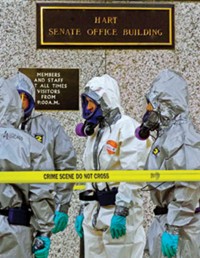Advertisement
Grab your lab coat. Let's get started
Welcome!
Welcome!
Create an account below to get 6 C&EN articles per month, receive newsletters and more - all free.
It seems this is your first time logging in online. Please enter the following information to continue.
As an ACS member you automatically get access to this site. All we need is few more details to create your reading experience.
Not you? Sign in with a different account.
Not you? Sign in with a different account.
ERROR 1
ERROR 1
ERROR 2
ERROR 2
ERROR 2
ERROR 2
ERROR 2
Password and Confirm password must match.
If you have an ACS member number, please enter it here so we can link this account to your membership. (optional)
ERROR 2
ACS values your privacy. By submitting your information, you are gaining access to C&EN and subscribing to our weekly newsletter. We use the information you provide to make your reading experience better, and we will never sell your data to third party members.
Safety
Bioterror Threat Seen As Growing
Nation is better prepared for bioattack, but budget cuts hamper readiness
by Glenn Hess
November 14, 2011
| A version of this story appeared in
Volume 89, Issue 46

Ten years after a series of anthrax-laced letters killed five people and alerted America to the risks posed by bioterrorism, the country is still not adequately prepared for a large-scale terrorist attack using a biological weapon, federal officials and biosecurity experts warn.
The U.S. has spent more than $65 billion on biodefense-related activities since 2001, Sen. Joseph I. Lieberman (I-Conn.), chairman of the Senate Homeland Security & Governmental Affairs Committee, noted at a hearing last month.
“Really we’ve done a lot more than the average American knows about to protect their security,” Lieberman remarked. First-responder capabilities have been strengthened, new vaccines have been developed, and forensic science techniques have improved, he said.
“But it is also clear from reports that we are not prepared for a catastrophic biological incident,” Lieberman pointed out. The nation is better prepared for a small-scale attack, but gaps remain there, too, he acknowledged.
“We lack a strategy for dispensing vaccines and antibiotics in a mass crisis, and tight budgets have led to an understaffed medical surge force to respond to a biological attack in communities around the country,” he said.
Lieberman convened the Oct. 18 hearing to examine the status of U.S. defenses against a potential bioterror strike. The need for such defenses was made clear a decade ago when—a week after the Sept. 11, 2001 terrorist attacks—letters containing anthrax spores were mailed to two congressional offices in Washington, D.C., and to several media outlets. Ultimately, five people died and 17 others were infected by the letters.
Some of those who study national security believe that the threat from bioweapons has been exaggerated and policymakers should focus on improving public health capabilities applicable to all infectious disease risks. “Public health in the U.S. faces many challenges; bioterrorism is just one,” the Scientists Working Group on Biological & Chemical Weapons said in a February 2010 analysis. The group is part of the Center for Arms Control & Non-proliferation, an advocacy organization.
But Tara J. O’Toole, the Department of Homeland Security’s (DHS) undersecretary for science and technology, told the Senate committee that the threat of a biological terror attack is real and the risk will increase as science advances.
“We know our adversaries are pursuing biological weapons,” O’Toole said. “The potency and accessibility of these weapons will increase as the bioscience revolution proceeds. The threat is not going to go away. It’s going to grow,” she warned.
Until recent years, most scientists had assumed that the difficulty of building a bioweapon was far beyond the ability of a terrorist cell. But scientific advances are making it possible for individuals to pursue ever more dangerous microbes, O’Toole said.
“Let me put it this way,” she remarked. “In the 1990s, it took billions of dollars and years to decode the human genome. Now, it can be done for thousands of dollars in about a week. This progress is happening globally.”
Alexander G. Garza, the DHS assistant secretary for health affairs, testified that a wide-area attack using the bacteria that causes anthrax—Bacillus anthracis—is one of the most serious mass casualty threats facing the U.S.
“A successful anthrax attack could potentially expose hundreds of thousands of people, and cause illness, death, fear, societal disruption, and economic damage,” Garza said. Even a small-scale attack, such as the attacks of a decade ago, “will result in deaths, panic, and economic losses, making this a weapon of mass disruption as well as destruction,” he noted.
However, the government has made progress in protecting the nation from biological attacks by implementing programs such as BioWatch, a nationwide biomonitoring system designed to detect the intentional release of aerosolized biological agents, he added.
Launched in 2001 in response to the anthrax mailings, BioWatch sensors now monitor more than 30 metropolitan areas across the country for the presence of a variety of deadly pathogens, including anthrax, smallpox, plague, and tularemia.
“BioWatch is much more than a machine,” Garza said. The program, he explained, has “evolved to become a robust network” of federal and state officials and local first responders that together would make decisions in the event of a biological attack.
Witnesses expressed concern, though, that budget cuts could undermine U.S. efforts to respond effectively to a bioterror attack. “We could face the sad irony that if another anthrax attack were to occur today, we may be better prepared than 10 years ago, but possibly not as well as three years ago,” said Jeffrey Levi, executive director of Trust for America’s Health, a Washington, D.C.-based advocacy group.
The significant investments the U.S. made in public health preparedness and infrastructure immediately after the 2001 terrorist and anthrax attacks led to “tremendous progress in our ability to prepare for and respond to an emergency. Unfortunately, these improvements cannot be maintained with one-time investments,” Levi told the panel.
Federal support for public health preparedness has been cut by 37% since fiscal 2005, and these cuts have been matched or exceeded at the state and local level as spending has been slashed in response to the recession and its aftermath, he noted.
“As a result,” Levi stated, “I worry deeply, as do my colleagues on the frontlines of public health agencies, that our capacity to respond to a new emergency will be severely diminished in the near future.”
Given current financial conditions, Lieberman said, it’s difficult to be optimistic about obtaining adequate funding for biodefense. Until the economy turns around, the budgetary pressures will “force us to make priority judgments,” he said.
Besides fiscal constraints, Sen. Susan M. Collins of Maine, the committee’s top Republican member, lamented that a “multitude of federal agencies”—DHS, the Department of Health & Human Services (HHS), the Department of Agriculture, and the Federal Bureau of Investigation, among others—share responsibility for preventing bioterrorism.
“It concerns me that so many different federal entities could be scrambling to respond during and after an attack. And, of course, state and local health officials and first responders are part of the system as well,” Collins said. “Yet the executive branch does not have one agency or one official that is the clearly designated leader on all elements of biodefense.”
Should a major attack occur, O’Toole said, President Barack Obama “will be in charge, in about 30 seconds,” and White House counterterrorism adviser John O. Brennan or his deputy will provide counsel. But she said a multiagency approach is necessary because “you need a lot of very detailed, specialized knowledge to have an informed, coherent response” to challenges such as the H1N1 influenza outbreaks in 2009, the BP oil spill in the Gulf of Mexico in 2010, and the nuclear crisis at Japan’s Fukushima Daiichi atomic energy plant earlier this year.
“We’re not going to be able to predict in advance exactly what constellation of experts we need,” O’Toole said. “We need to have an agile capacity to assemble and reassemble and restructure the capacities of the U.S. government as needed.”
Nicole Lurie, the assistant secretary for preparedness and response at HHS, agreed with that assessment and said the various federal agencies that prepare for public health emergencies are well coordinated.
“At the end of the day, with each of the emergencies that we have faced, we all sat together in the White House Situation Room led by national security staff and worked through plans and operational responses,” Lurie testified. “And because we work so closely together now day-to-day on all of these other issues, it has actually been really easy.”
However, Robert P. Kadlec, who served as senior director for biodefense policy during the George W. Bush Administration, said the White House needs an official who is fully devoted to addressing the threat posed by biological weapons.
“I’ll use a football analogy,” Kadlec said to the Senate committee. “We have a lot of great assistant coaches. The question is, ‘Where is the head coach?’ ”
Kadlec’s position was eliminated by the Obama Administration in 2009, a decision that “clearly demonstrates that today, the threat of a biological Hiroshima is not viewed with the same concern and urgency as the potential for a nuclear one,” he asserted in his testimony before the panel.
In 2008, a congressionally chartered commission said an attack involving a weapon of mass destruction (WMD) was likely to occur somewhere in the world by 2013 unless dramatic precautions were taken. It also stated that a biological strike was more likely than a nuclear attack because of the worldwide availability of deadly pathogens.
In an updated assessment released last month (C&EN, Oct. 17, page 42), the Bipartisan WMD Terrorism Research Center, led by former Sens. Bob Graham (D-Fla.) and Jim Talent (R-Mo.), says the U.S. has made limited progress in strengthening its capacity to respond to a biological attack and remains vulnerable to multiple threats.
The group’s report says that advances in biotechnology have now enabled a small team of individuals with college-level training to create biological weapons. “Too few leaders in government or the private sector fully understand the growing threat of bioterrorism—and its potential consequences,” the report warns.
The WMD Center recommends that the U.S. focus less on trying to prevent an attack and more on increasing investment in diagnostic tools, vaccines, antibiotics, and other treatments to limit the impact of a biological strike, and thus possibly deter terrorists.
In 2004, Congress passed the Project BioShield Act to provide research grants and other incentives to encourage the private sector to develop new medical countermeasures for use against biological weapons and other threats. The law is set to expire in 2012.
According to the WMD Center’s report, the government has enough smallpox vaccine in its civilian stockpile to inoculate the entire U.S. population. Available countermeasures could also “limit the impact of small-scale attacks using anthrax and several other likely pathogens, but [supplies] may not be adequate for large-scale attacks.”
The process for developing and producing medical countermeasures, the report concludes, “still lacks clearly defined requirements, a common set of prioritized research and development goals … and sufficient, sustained funding.”
“The good news is that everybody who is aware of this threat wants to prevent it,” Talent remarked at an Oct. 12 briefing in Washington, D.C. “The problem is that there’s just not a high enough level of awareness.”




Join the conversation
Contact the reporter
Submit a Letter to the Editor for publication
Engage with us on Twitter